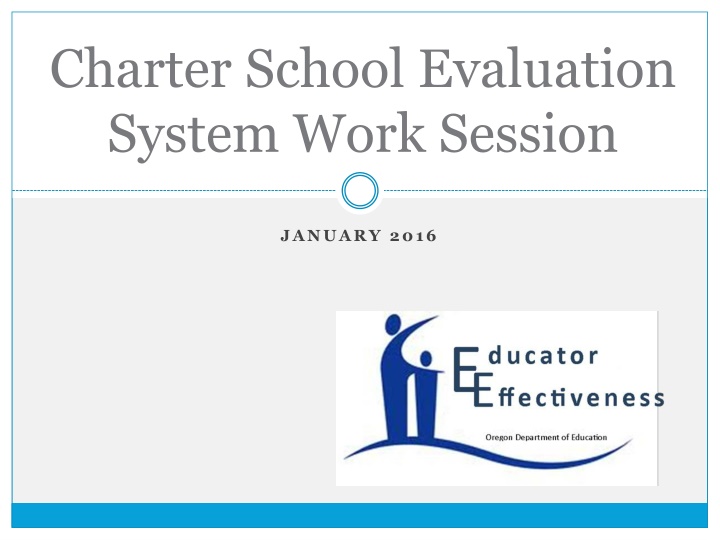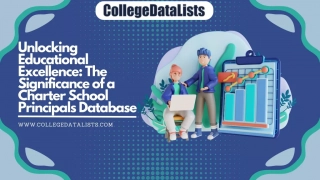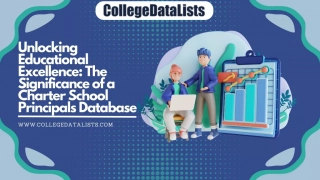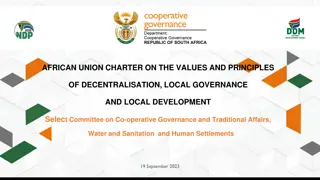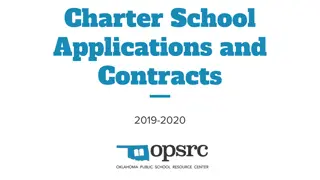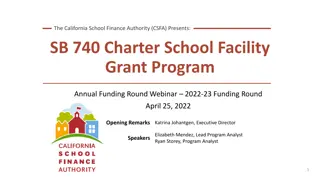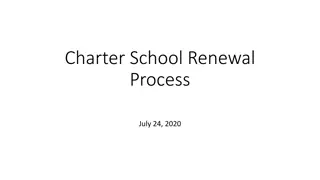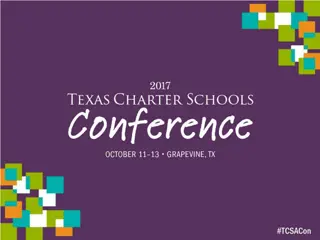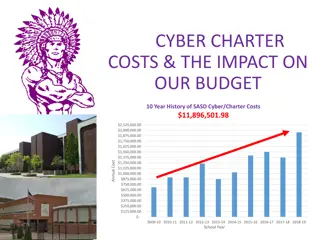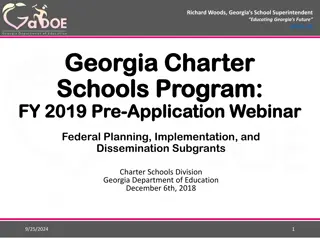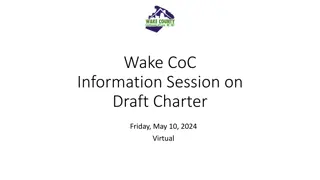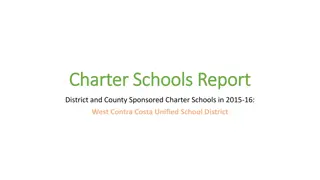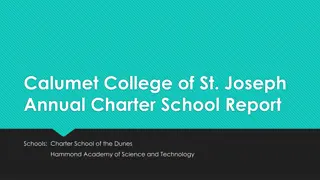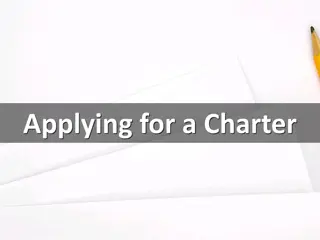Charter School Evaluation System Work Session - January 2016
Outcomes for Today: Review the required components of an evaluation system, provide differentiated supports, develop an action plan. Explore Oregon Framework for Teacher and Administrator Evaluation and Support Systems. Understand the purpose of an Evaluation & Support System and the required elements. Learn about Standards of Professional Practice and Differentiated Performance Levels.
Download Presentation

Please find below an Image/Link to download the presentation.
The content on the website is provided AS IS for your information and personal use only. It may not be sold, licensed, or shared on other websites without obtaining consent from the author.If you encounter any issues during the download, it is possible that the publisher has removed the file from their server.
You are allowed to download the files provided on this website for personal or commercial use, subject to the condition that they are used lawfully. All files are the property of their respective owners.
The content on the website is provided AS IS for your information and personal use only. It may not be sold, licensed, or shared on other websites without obtaining consent from the author.
E N D
Presentation Transcript
Charter School Evaluation System Work Session JANUARY 2016
Outcomes for Today Review the required components of an evaluation system Based on level of readiness, provide differentiated supports to move your planning process forward Develop an action plan with your team for next steps beyond today s session
OregonFramework for Teacher and Administrator Evaluation and Support Systems Alignment of State and Federal Requirements Oregon Framework ESEA Waiver SB 290 The Oregon Framework incorporates SB290 and federal requirements Guides implementation of aligned state & federal requirements HB 2186 in 2015 session added charter schools OAR 581-022-1723
Purpose of an Evaluation & Support System Improve instructional, professional and leadership practices Engage every educator as an active participant in their evaluation Ensure the process promotes collaboration and continuous learning Improve student growth and prepare students for College, Careers and Citizenship
Oregon Framework Required Elements Elements must be included in all teacher and administrator evaluation and support systems: 1. Standards of Professional Practice 2. Differentiated Performance Levels: 4 Levels 3. Multiple Measures 4. Evaluation and Professional Growth Cycle 5. Aligned Professional Learning Must align to requirements, but flexibility in local design
Standards of Professional Practice Administrators Teachers EducationalLeadership/ Administrator Standards (ISLLC) Six Domains: Visionary Leadership Instructional Improvement Effective Management Inclusive Practice Ethical Leadership Socio-Political Context Model Core Teaching Standards (InTASC) o Four Domains/10 Standards: The Learner and Learning Content Instructional Practice Professional Responsibility 1. 1. 2. 2. 3. 4. 3. 4. 5. 6.
Differentiated Performance Levels Performance evaluated on the Standards of Professional Practice on 4 levels Level 1 Does not meet standards Level 2 Making progress toward standards Level 3 Meets standards Level 4 Exceeds standards Proficient
Multiple Measures (A)Professional Practice (C) Student Learning and Growth (B)Professional Responsibilities
Professional Practice Evidence of the quality of the teacher s planning, delivery of instruction, and assessment of student learning. Observations (minimum of 2) Evaluator s observation, documentation and feedback on a teacher s instructional practices; both formal and informal Artifacts Lesson plans, curriculum design, scope and sequence, student assignments, student work
Professional Responsibility Evidence of the teacher s progress toward their own professional goals and contribution to school-wide goals. Examples: Teacher reflections, self-reports, data analysis, professional goal setting, student growth goal setting, records of contributions, peer collaboration, teamwork, parent/student surveys, meetings, record keeping, portfolios, building level leadership (committees, demonstration classrooms)
Student Learning and Growth (SLG) Evidence of the teacher s contribution to student learning and growth. All teachers set and score two goals each year Category 1 goals are measured using statewide assessments in ELA and math Category 2 goals are measured using school-wide or district-wide assessments Collaborative process that includes mid-year check in for conversation on progress
Factors in Summative Effectiveness Rating Professional Responsibilities Student Learning & Growth Professional Practice Summative Effectiveness Rating Oregon Matrix
Determining a Final Score: Oregon Matrix Collegial *SLG Inquiry 3 3 or 4 Collegial or Consulting *SLG Inquiry 2 or 3 3 Consulting 2 2 Directed 1 1 LEVEL 1 LEVEL 2 *Inquiry Process Facilitative or Collegial * SLG Inquiry Facilitative 4 Facilitative 4 LEVEL 4 Collegial Collegial 3 Consulting 2 Consulting or Directed * PP/PR Inquiry 1 or 2 Collegial 3 Collegial or Consulting * PP/PR Inquiry 2 or 3 Consulting * PP/PR Inquiry 2 LEVEL 4 Y-Axis: PP / PR LEVEL 3 Consulting LEVEL 2 Directed LEVEL 1 LEVEL 3 X-Axis: SLG
Evaluation and Professional Growth Cycle Educator conducts an assessment of practice against performance standards Self-Reflection Culmination of multiple formative observations, reflections, professional conversations Educator strategically identifies professional practice and student learning goals Summative Evaluation Goal Setting Educator and evaluator review progress toward goals and/or performance against standards Educator and evaluator collect evidence using multiple measures Observation & Collection of Evidence Formative Assessment
Aligned Professional Learning Evaluation aligned with high quality professional development opportunities Relevant to educator s goals and needs Informs decisions for professional growth Standards for Professional Learning http://www.learningfor ward.org/standards
Materials for Todays Work Your completed Process Tool Sample systems on website (David Douglas & Philomath), one on flash drive Handbook template Implementation guidance Action Planning template Oregon Framework Survey
Todays Work Session With your team, select the appropriate level of readiness: Yellow - Our team has not completed the Process Tool Blue - Our team has completed the Process Tool, but we do not have a formal evaluation handbook Green - Our team has completed the Process Tool and has a formal evaluation handbook that needs adjustments to align with the requirements of the Oregon Framework Pink - Our team has completed the Process Tool and is using a system that fully aligns with the Oregon Framework
Before we break for lunch Questions or discussion points for the group? ESEA Reauthorization Every Student Succeeds Act (ESSA)
ESEA Reauthorization The Every Student Succeeds Act (ESSA) reauthorizes the Elementary and Secondary Education Act (ESEA) and replaces the No Child Left Behind (NCLB) Act. Reauthorization period FY2017 thorough FY2020.
Major ESSA Timelines ESEA Waivers null and void August 1, 2016 Continue to support focus/priority schools that fail to meet exit criteria in 2016- 17 SY. State law & OARs (SB 290 - educator evaluations) remain in effect. New accountability requirements take effect in 2017-18 SY Federal Grant Programs Noncompetitive formula grants effective July 1, 2016. Competitive grants effective October 1, 2016. Federal Rulemaking by the U.S. Department of Education Draft regulations December 2015 - May 2016. Public input on draft rules May 2016 (60 days). Review comments, draft final regulations July October 2016. Publish final regulations October 26, 2016.
Oregons Rollout Timeline 2015-16 School Year ODE will communicate transition plans in January. ODE establish stakeholder work groups in January-February. Convene stakeholder workgroups February-June to begin developing Oregon s State Plan. 2016-17 School Year Transition year to develop policy, guidance, OARs based on final regulations from USED. Finalize State Plan and submit to USED for approval. 2017-18 School Year Implementation of accountability system identified in State Plan.
Assessments ESSA NCLB Title I-A funding required state testing in reading and math annually in grades 3-8 and once in high school; and in science annually in grades 3-5, 6-8, and 10-12. Same testing requirements Allows states to use a single annual summative assessment or multiple interim assessments that result in one summative score. Allows districts to use other nationally recognized tests in high school, approved by the state.
Assessments cont. ESSA NCLB Title I-A funding allowed states to administer alternative tests to students with disabilities; to be used by no more that 1% of the students being assessed. Allows states to administer alternate tests for students with the most significant cognitive disabilities; 1% cap still applies. Maintains 95% participation requirement but state creates its own opt out policy and decide how to include in its accountability system. Required states to administer assessments to at least 95% of each student subgroup.
Teacher and Leader Effectiveness ESSA NCLB Required 100% of teachers in core academic subjects to be highly qualified. BS degree, Demonstrate subject-matter knowledge in subject they teach, and Hold certification or license in subject they teach. Eliminates highly qualified teacher (HQT) requirements. Requires state to provide assurances that all teachers and paraprofessionals in Title 1-A funded schools meet state certification and licensure requirements. Districts must report experience, credentials, teaching out of field in the Report Card; disaggregated by high/low poverty.
Teacher and Leader Effectiveness cont. ESSA NCLB The ESEA waiver for NCLB required states to develop teacher and principal evaluation and support systems that included state assessments as a measure of student growth in tested grades and subjects (ELA/math; grades 3-8 and high school). Does not require teacher or principal evaluation systems. But if Title II funds are used to create or change evaluation systems, they must be based in part on evidence of student achievement, which may include student growth; must include multiple measures of educator performance; and provide clear, timely, useful feedback. Note: State law (SB290) and Oregon Administrative rule remain in effect.
Well-Rounded Education ESSA NCLB Eliminates 50 individual programs and creates new a block grant. Funds for Student Support and Academic Enrichment grants for: Well-rounded education - e.g. counseling, music and arts, accelerated learning, STEM Safe and healthy students. Effective use of technology. Continues 21st Century Community Learning Centers as a stand-alone program. Authorizes Family Engagement Centers. Title IV-A funding included a variety of programs and funding authority to support a well- rounded education, including arts education, school counseling, physical education, and 21st century learning community centers.
ESSA Resources & Links Oregon Dept. of Education ODE s Summary of ESEA Reauthorization framework Please note that it is 391 pages Every Student Succeeds Act Every Student Succeeds Act ESSA bill US Dept. of Education http://www.ed.gov/ESSA http://www.ed.gov/ESSA Education Week Article by Alyson Klein ESEA Reauthorization: ESSA Explained ESEA Reauthorization: ESSA Explained ESEA Reauthorization: ESSA Explained
Timeline for Charter Schools 2015-16 Design Year Establish a collaborative process/team that includes teachers Review current evaluation practice and processes to capitalize on what you are already doing Create a handbook aligned to the Framework requirements Learn about Student Learning and Growth Goals Develop a plan for implementation
Thinking about Implementation 2016-17 Implementation Conduct all teacher evaluations using the aligned system Write Student Learning and Growth (SLG) goals Provide professional learning on the system and tools for all staff Provide professional learning for evaluators on observation, calibration and feedback Implement a system for gathering and tracking evidence related to the evaluation Charter school evaluation systems must be fully implemented beginning in 2016-17
Processing Based on the work your team did today, what are the areas of focus for the remaining work?
Work until youre done! Before you leave today Complete the action planning template outlining the remaining work for your team to accomplish Complete the survey to inform follow-up regional support from ODE in Spring/Summer 2016. Please reach out to any of our team members for support! Kate Pattison kate.pattison@state.or.us Tanya Frisendahl tanya.frisendahl@state.or.us Sarah Martin sarah.martin@state.or.us Brian Putnam brian.putnam@state.or.us
